Actor portrayal.
If your patient has cardiometabolic risk factors, ACT AGAINST THE UNDERLYING THREAT OF MASH
Actor portrayal.
MASH was referred to as nonalcoholic steatohepatitis (NASH) prior to 2023.1*
Metabolic dysfunction-associated steatohepatitis (MASH)* is a chronic, often progressive, and potentially life-threatening liver disease.2,3 Caused by a buildup of excess fat in the liver (steatosis), MASH is characterized by liver inflammation and ballooning, with or without fibrosis.4,5
Often considered a "silent" disease, MASH can go unaddressed, which can lead to serious consequences.2,6 Early intervention is essential for long-term management—yet the majority of US cases are undiagnosed.7,8
Now is the time to act. Test your at-risk patients.
“NASH” is now “MASH”1*
Nonalcoholic steatohepatitis (NASH) is now referred to as metabolic dysfunction-associated steatohepatitis (MASH). This updated name more accurately reflects its etiology.1
MASH is a more severe form of MASLD9
The revised nomenclature emphasizes the critical role of metabolic dysfunction in both metabolic dysfunction-associated steatotic liver disease (MASLD) and its more severe form, MASH.1,9
Get to Know MASH: Understanding the Mechanism of Disease
This video explains the pathophysiology that leads to the development of MASH, a progressive liver disease. This includes a key role of insulin resistance in accumulation of fat in the liver (steatosis), which may lead to development of scarring (fibrosis) and cirrhosis.
MASH is characterized by steatosis, inflammation, and ballooning10
If MASH progresses, it can increase the risk of significant complications such as10-13:
- Cardiovascular disease
- Hepatocellular carcinoma
- Liver-related and all-cause mortality†
Spectrum of MASLD4,14-17
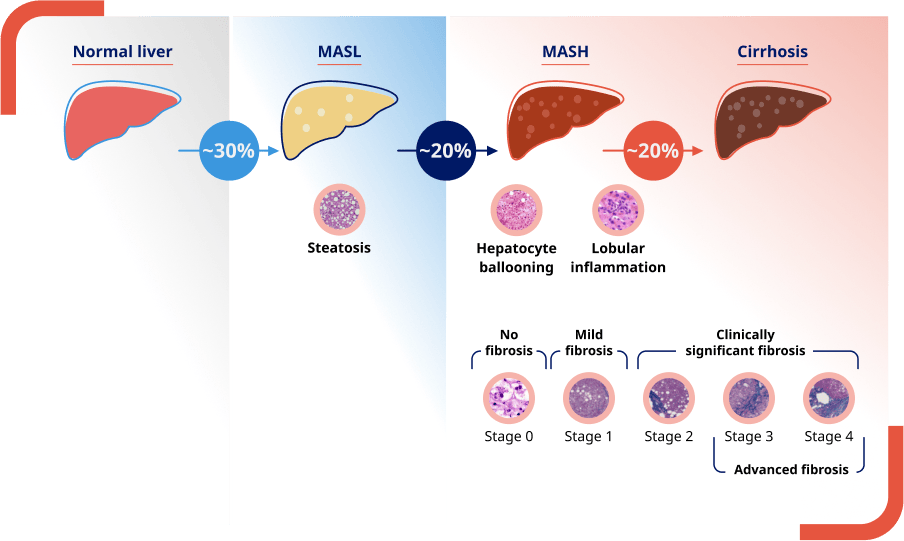
Improve MASH diagnosis
Despite high disease burden, MASH is underdiagnosed8,18,19

>1.8 million patients were diagnosed with MASH in the US annually (from 2016-2020).20‡

In the US, MASH is the #1 reason for liver transplants in women and those >65 years and is expected to become the leading indication for liver transplantation overall.21

MASH progression is often slow, but some people may experience rapid progression from no fibrosis (F0) to advanced fibrosis (F3-F4) in ~6 years.16,22,23
For people with MASH, prompt diagnosis and management are crucial.24
Spot the subtle symptoms of MASH
When present, the symptoms of MASH are often non-specific and may be incorrectly attributed to other comorbidities6,24
Symptoms associated with MASH may include25:

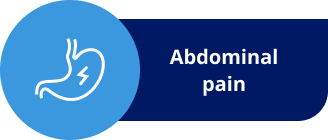



Consider common comorbidities of MASH
There is a wide range of metabolic comorbidities in patients with MASH26,27

Cardiovascular
Valvular heart disease
Left ventricular dysfunction
Cardiac arrhythmias
Myocardial infarctions

Vascular
Atherogenic dyslipidemia
Coronary artery disease

Hepatic
Gallstones disease
Progressive liver fibrosis
Liver cirrhosis
Hepatocellular carcinoma

Pancreatic
Type 2 diabetes

Renal
Chronic kidney disease

Cardiovascular
Valvular heart disease
Left ventricular dysfunction
Cardiac arrhythmias
Myocardial infarctions

Vascular
Atherogenic dyslipidemia
Coronary artery disease

Hepatic
Gallstones disease
Progressive liver fibrosis
Liver cirrhosis
Hepatocellular carcinoma

Pancreatic
Type 2 diabetes

Renal
Chronic kidney disease

Extrahepatic malignancies
Colorectal
Stomach
Pancreas

Neurological complications
Cerebrovascular infarctions
Neurocognitive dysfunction and depression

Endocrine
Thyroid dysfunction

Reproductive
Polycystic ovarian syndrome
Breast cancer

Respiratory
Obstructive sleep apnea

Extrahepatic malignancies
Colorectal
Stomach
Pancreas

Neurological complications
Cerebrovascular infarctions
Neurocognitive dysfunction and depression

Endocrine
Thyroid dysfunction

Reproductive
Polycystic ovarian syndrome
Breast cancer

Respiratory
Obstructive sleep apnea
This graphic is not inclusive of all potential comorbidities associated with MASLD and MASH.
Identify at-risk patients
Identify at-risk patients
MASLD is now considered the hepatic manifestation of the metabolic syndrome9
There is significant overlap between MASLD/MASH and other metabolic diseases.10,28
For this reason, patients with the following comorbidities should be periodically screened for MASH/advanced fibrosis10,29:
- Two or more metabolic risk factors
- Medically complicated obesity
- Prediabetes or type 2 diabetes
- Hepatic steatosis
- Family history of cirrhosis
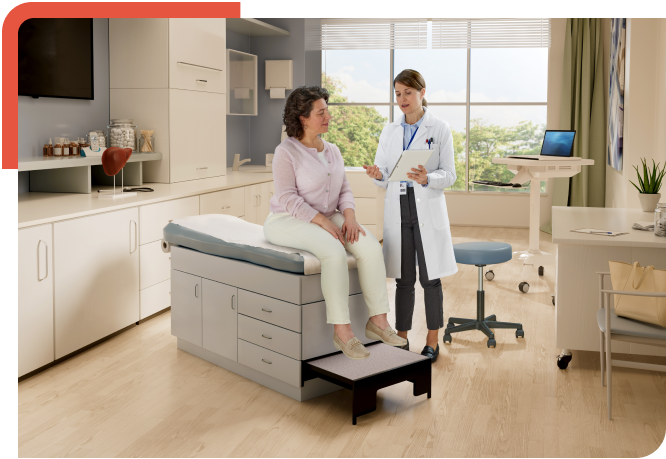
Actor portrayal.
Screen for MASH

Screen for MASH
National guidelines for screening
Diagnosis of MASH has traditionally involved liver biopsy, but there is greater need for and acceptance of noninvasive tests to screen for and diagnose MASH.21
Adaptations of current guidelines from accredited organizations are provided below to inform screening practices.
The AGA assembled a multidisciplinary panel of experts to develop a Clinical Care Pathway, providing guidance on the screening, diagnosis, and management of MASLD.29
Step I:
Identify those with 2 or more metabolic risk factors,* type 2 diabetes, steatosis, or elevated aminotransferases.
Step II:
Take medical history to evaluate excessive alcohol intake, and request laboratory testing for CBC and liver function.
Step III:
Carry out noninvasive FIB-4 assessment for fibrosis (FIB-4 is a calculated value based on age, AST, ALT, and platelet count)†‡§:
- If FIB-4 <1.3: low risk. Repeat test in 2 to 3 years unless there is a change in clinical circumstance.
- If FIB-4 1.3 to 2.67: indeterminate risk. Order liver stiffness measurement (LSM) to estimate risk¶||#:
- LSM <8 kPa: low risk. Repeat test in 2 to 3 years unless there is a change in clinical circumstance.
- LSM >12 kPa: high risk. Refer to a hepatologist.
- LSM 8 kPa to 12 kPa: indeterminate risk. Refer to hepatologist for liver biopsy, MR elastography, or monitoring with re-evaluation of risk in 2-3 years.
- If FIB-4 >2.67: high risk. Refer to a hepatologist.
- Metabolic risk factors: central obesity, high triglycerides, low HDL cholesterol, hypertension, prediabetes, or insulin resistance.
- For patients 65+, use FIB-4 <2.0 as the lower cutoff. Higher cutoff does not change.
- Other NITs derived from routine laboratories can be used instead of FIB-4.
- Many online FIB-4 calculators are available.
- Ultrasound acceptable if VCTE (FibroScan®) is unavailable. Consider referral to hepatologist for patients with hepatic steatosis on ultrasound who are indeterminate or high risk based on FIB-4.
- LSM values are for VCTE (FibroScan®). Other techniques such as bidimensional shear wave elastography or point shear wave elastography can also be used to measure LSM. Proprietary commercially available blood NITs may be considered for patients considered indeterminate or high risk based on FIB-4 or APRI, or where LSM is unavailable.
- Eddowes et al, 2019 used 8.2 and 12.1 kPa as cutoffs for LSM using VCTE. Validation of simple (rounded) cutoffs reported by Papatheodoridi et al, 2021.
To identify clinically significant fibrosis (stage ≥2), the AASLD recommends targeted screening of populations at increased risk of advanced liver disease10:
- Type 2 diabetes
- Medically complicated obesity
- MASLD in context of moderate alcohol use
- First-degree relative of a patient with cirrhosis due to MASLD/MASH
The AASLD recommends that patients with metabolic risk factors undergo regular risk assessments depending on their likelihood of having advanced fibrosis.10

Adapted from Rinella ME, Neuschwander-Tetri BA, Siddiqui MS, et al. AASLD practice guidance on the clinical assessment and management of nonalcoholic fatty liver disease. Hepatology. 2023;77(5):1797-1835.
Algorithm for the evaluation of patients at risk for or with established MASLD across practice settings. Patients with steatosis noted on imaging or for whom there is a clinical suspicion of MASLD, such as those with metabolic risk factors or unexplained elevation in liver chemistries, should undergo further evaluation. In settings with a low prevalence of advanced fibrosis, such as in the primary care setting, the emphasis is on excluding advanced fibrosis using a test with a high negative predictive value. When the fibrosis-4 index (FIB-4) is <1.3, patients can be followed in the primary care setting and reassessed periodically. Patients without prediabetes/type 2 diabetes (T2D) and 1–2 metabolic risk factors can be reassessed every 2–3 years. Patients with prediabetes/T2D or 2 or more metabolic risk factors are at higher risk for disease progression, and more frequent FIB-4 monitoring (eg, every 1–2 years) should be considered. In patients older than age 65, a FIB-4 cutoff of >2.0 should be used. FIB-4 has low accuracy in those under age 35; thus, secondary assessment should be considered in those <35 with increased metabolic risk or elevated liver chemistries. FIB-4 should not be used in acutely ill patients. In patients with FIB-4≥1.3, a secondary assessment should be done (preferentially vibration-controlled elastography [VCTE] or Enhanced Liver Fibrosis™ [ELF™] initially) or the patient referred for further risk stratification (if being seen in a nongastroenterology/hepatology setting). Direct referral to gastroenterology/hepatology should be considered in those with aminotransferases persistently (>6 months) above normal to exclude other causes of liver disease or when FIB-4>2.67 due to the increased risk of clinically significant fibrosis. In higher prevalence settings, such as gastroenterology/hepatology clinics, additional risk assessment with magnetic resonance elastography (MRE) may be appropriate when noninvasive tests (NITs) are indeterminate or there is clinical suspicion of more advanced disease. Identification of cirrhosis should prompt screening for HCC and esophageal varices. In addition, MRE or corrected T1 (cT1) may help identify patients with “at-risk” MASH (MASH with MASLD activity score ≥4 and fibrosis stage ≥2) who may benefit from a therapeutic intervention as they become available. If cirrhosis is suspected based on NITs, clinical data, or imaging findings, then cirrhosis-based management may be initiated without a liver biopsy. Liver biopsy should be considered when NITs suggest significant fibrosis (≥F2), especially if additional evaluation suggests the presence of “at-risk” MASH (eg, using FAST, MEFIB, MAST, or cT1), NIT assessment is indeterminate, aminotransferases are persistently elevated (>6 months), or additional/alternate diagnoses are suspected. Note that in patients with confirmed or suspected advanced fibrosis, an ELF™≥11.3 is a predictor of future liver-related events and is approved for this purpose; use of other ELF™ cutoffs in secondary risk assessment is based on expert option. Patients at all stages of disease should be counseled on lifestyle modifications, and those with ≥F2 fibrosis targeted for pharmacological interventions as they become available. Specific threshold values of NITs are approximations supported by current evidence and are meant to guide clinical management through primary care to gastroenterology/hepatology practices rather than be interpreted in isolation.10
The AACE has published guidelines to provide endocrinologists and PCPs with practical, evidence-based recommendations for the diagnosis of MASLD in adults. Below is a summary of recommendations.30
Q2.1 Which adults with MASLD should be considered at “high risk” of clinically significant fibrosis (stages F2-F4) and at risk of cirrhosis?
R2.1.1 Clinicians should consider persons with obesity and/or features of metabolic syndrome, those with prediabetes or T2D, and those with hepatic steatosis on any imaging study and/or persistently elevated plasma aminotransferase levels (over 6 months) to be “high risk” and screen for MASLD and advanced fibrosis.
Grade B; Intermediate/High Strength of Evidence; BEL 2
R2.1.2 Persons undergoing bariatric surgery should be evaluated for the presence and severity of MASH, and a liver biopsy should be considered at the time of bariatric surgery. Liver biopsy should be recommended if presurgical stratification suggests indeterminate or high risk of liver fibrosis.
Grade B; Intermediate Strength of Evidence; BEL 2
Q2.2 What blood tests (eg, diagnostic panels and specific biomarkers) can be used to diagnose MASLD with clinically significant fibrosis (stages F2-F4) in adults?
R2.2.1 Clinicians should use liver fibrosis prediction calculations to assess the risk of MASLD with liver fibrosis. The preferred noninvasive initial test is the FIB-4.
Grade B; Intermediate Strength of Evidence; BEL 2
R2.2.2 Clinicians should consider persons belonging to the “high-risk” groups (as defined under R2.1.1) who have an indeterminate or high FIB-4 score for further workup with an LSM (transient elastography) or ELF™ test, as available.
Grade B; Intermediate Strength of Evidence; BEL 2
Q2.3 What imaging studies can be used to diagnose MASLD with clinically significant fibrosis (stages F2-F4) in adults?
R2.3 To stage the risk of fibrosis in persons with MASLD, clinicians should prefer the use of VCTE as best validated to identify advanced disease and predict liver-related outcomes. Alternative imaging approaches may be considered, including shear wave elastography (less well validated) and/or magnetic resonance elastography (most accurate but with a high cost and limited availability; best if ordered by liver specialist for selected cases).
Grade B; Intermediate Strength of Evidence; BEL 2
Q2.4 Should all persons with diabetes be screened for clinically significant fibrosis (stages F2-F4) associated with MASLD?
R2.4.1 In persons with T2D, clinicians should consider screening for clinically significant fibrosis (stages F2-F4) using the FIB-4, even if they have normal liver enzyme levels.
Grade B; High/Intermediate Strength of Evidence; BEL 2
R2.4.2 In persons with T1D, clinicians may consider screening for MASLD with clinically significant fibrosis (stages F2-F4) using the FIB-4, only if there are risk factors such as obesity, features of metabolic syndrome, elevated plasma aminotransferase levels (>30 U/L), or hepatic steatosis on imaging.
Grade C; Intermediate/Weak Strength of Evidence; BEL 2; downgraded based on the heterogeneity of studies and moderate-to-high probability of bias
R2.4.3 Clinicians should further risk stratify persons with T2D, or T1D with cardiometabolic risk factors and/or elevated plasma aminotransferase levels (>30 U/L) using the FIB-4, elastography, and/or ELF™ test.
Grade B; High/Intermediate Strength of Evidence; BEL 2
Q2.5 When should an adult be referred to a gastroenterologist/hepatologist for management?
R2.5.1 Persons with persistently elevated ALT or AST levels and/or with hepatic steatosis on imaging and indeterminate risk (FIB-4, 1.3-2.67; LSM, 8-12 kPa; or ELF™ test, 7.7-9.8) or high risk (FIB-4, >2.67; LSM, >12 kPa; or ELF™ test, >9.8) based on blood tests and/or imaging (as described in R2.2.1, R2.2.2, and R2.3) should be referred to a gastroenterologist or hepatologist for further assessment, which may include a liver biopsy.
Grade B; Intermediate Strength of Evidence; BEL 2
R2.5.2 Clinicians should refer persons with clinical evidence of advanced liver disease (ascites, hepatic encephalopathy, esophageal varices, or evidence of hepatic synthetic dysfunction) to a gastroenterologist/hepatologist for further care.
Grade B; Intermediate/High Strength of Evidence; BEL 2
The AACE offers detailed recommendations for the diagnosis of MASLD in both adults and children. To see a full list of recommendations, visit the AACE website.
>2 out of 5 patients with MASLD have metabolic syndrome.31
Have you identified which of your patients are at risk?
Discuss lifestyle changes to help manage MASH
The AGA recommends lifestyle interventions based on patient risk for advanced fibrosis29
Communicate the importance of lifestyle interventions to long-term success with your patients.29
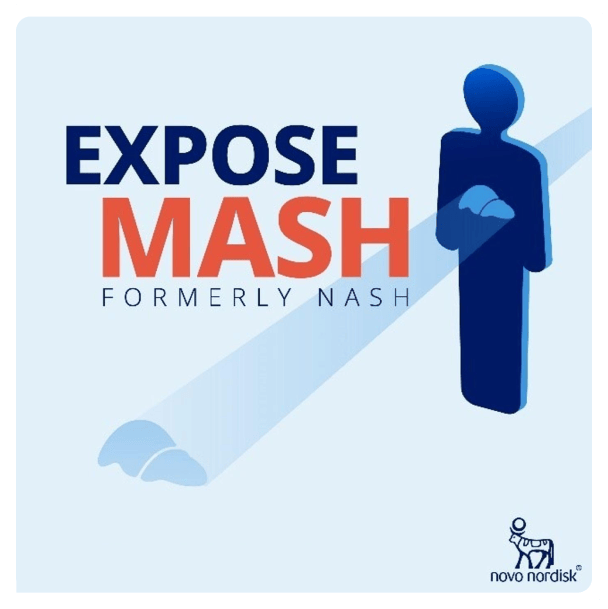
Expose MASH Podcast
Recent advances in understanding steatotic liver disease have revealed overlapping biological processes that may contribute to nonalcoholic fatty liver disease (NAFLD). Join us in this podcast series where your colleagues will take you on a journey to better understand the cardiometabolic basis for MASH, formerly known as NASH, which has long been recognized as “the hepatic manifestation of the metabolic syndrome.” In this series, we will explore MASH, including the epidemiology, pathophysiology, comorbidities, patients at risk, and healthcare professionals' perspectives on the patient journey. This series is tailored specifically for healthcare professionals seeking deeper insights into MASH.
Expose MASH [Formerly NASH] is tailored for healthcare professionals seeking to stay at the forefront of liver disease knowledge. This podcast is sponsored by Novo Nordisk and is intended for U.S. clinicians. This podcast is not to be used as medical advice.
Expose MASH [Formerly NASH] is tailored for healthcare professionals seeking to stay at the forefront of liver disease knowledge. This podcast is sponsored by Novo Nordisk and is intended for U.S. clinicians. This podcast is not to be used as medical advice.
Stay connected and up-to-date with the latest information and resources about MASH from Novo Nordisk
- A consensus on a nomenclature change (from NASH to MASH, and NAFLD to MASLD) was developed by a multistakeholder effort led by the American Association for the Study of Liver Diseases (AASLD) and the European Association for the Study of the Liver (EASL). Endorsing organizations include the American Association of Clinical Endocrinology (AACE) and American Gastroenterological Association (AGA).1
- Based on a meta-analysis of studies in the Medline and Embase databases of articles related to survival outcomes in patients with MASLD from inception to November 11, 2021. The initial search yielded 727 articles, of which 14 studies (N=17,301 patients) met inclusion criteria and were included in the analysis.13
- Based on data from a retrospective study that used a large database (Explorys® IBM®) of aggregated electronic health records from 26 healthcare systems in the US.20
ALT=alanine aminotransferase; APRI=AST to platelet ratio index; AST=aspartate aminotransferase; BEL=best evidence level; CBC=complete blood count; ELF™=Enhanced Liver Fibrosis™ test; FAST=FibroScan®-aspartate aminotransferase; FIB-4=Fibrosis-4; HCC=hepatocellular carcinoma; HDL=high-density lipoprotein; LSM=liver stiffness measurement; MASL=metabolic dysfunction-associated steatotic liver; MAST=magnetic resonance imaging-aspartate aminotransferase; MEFIB=magnetic resonance elastography plus Fibrosis-4; MRE=magnetic resonance elastography; NIT=noninvasive test; PCP=primary care provider; T1D=type 1 diabetes; T2D=type 2 diabetes; VCTE=vibration-controlled transient elastography.
References:
- Rinella ME, Lazarus UV, Ratziu V, et al. NAFLD Nomenclature consensus group. A multisociety Delphi consensus statement on new fatty liver disease nomenclature. J Hepatol. 2023;79(6):1542-1556.
- Ilan Y. Analogy between nonalcoholic steatohepatitis (NASH) and hypertension: a stepwise patient-tailored approach for NASH treatment. Ann Gastroenterol. 2018;31(3):296-304.
- Tesfay M, Goldkamp WJ, Neuschwander-Tetri BA. NASH: the emerging most common form of chronic liver disease. Mo Med. 2018;115(3):225-229.
- Chalasani N, Younossi Z, Lavine JE, et al. The diagnosis and management of nonalcoholic fatty liver disease: practice guidance from the American Association for the Study of Liver Diseases. Hepatology. 2018;67(1):328-357.
- Kanda T, Matsuoka S, Yamazaki M, et al. Apoptosis and nonalcoholic fatty liver diseases. World J Gastroenterol. 2018;24(25):2661-2672.
- Balp MM, Krieger N, Przybysz R, et al. The burden of nonalcoholic steatohepatitis (NASH) among patients from Europe: a real-world patient-reported outcomes study. JHEP Rep. 2019;1(3):154-161.
- Hallsworth K, Adams LA. Lifestyle modification in NAFLD/NASH: facts and figures. JHEP Rep. 2019;1(6):468-479.
- Nadolsky K, Cryer DR, Articolo A, et al. Nonalcoholic steatohepatitis diagnosis and treatment from the perspective of patients and primary care physicians: a cross-sectional survey. Ann Med. 2023;55(1):2211349.
- Kim CH, Younossi ZM. Nonalcoholic fatty liver disease: a manifestation of the metabolic syndrome. Cleve Clin J Med. 2008;75(10):721-728.
- Rinella ME, Neuschwander-Tetri BA, Siddiqui MS, et al. AASLD practice guidance on the clinical assessment and management of nonalcoholic fatty liver disease. Hepatology. 2023;77(5):1797-1835.
- Younossi ZM, Henry L. Epidemiology of nonalcoholic fatty liver disease and hepatocellular carcinoma. JHEP Rep. 2021;11;3(4):100305.
- Targher G, Byrne CD, Tilg H. NAFLD and increased risk of cardiovascular disease: clinical associations, pathophysiological mechanisms and pharmacological implications. Gut. 2020;69(9):1691-1705.
- Ng CH, Lim WH, Hui Lim GE, et al. Mortality outcomes by fibrosis stage in nonalcoholic fatty liver disease: a systematic review and meta-analysis. Clin Gastroenterol Hepatol. 2023;21(4):931-939.e5.
- Younossi ZM, Golabi P, Paik JM, et al. The global epidemiology of nonalcoholic fatty liver disease (NAFLD) and nonalcoholic steatohepatitis (NASH): a systematic review. Hepatology. 2023;77(4):1335-1347.
- Francque S, Vonghia L. Pharmacological treatment for nonalcoholic fatty liver disease. Adv Ther. 2019;36(5):1052-1074.
- Estes C, Razavi H, Loomba R, et al. Modeling the epidemic of nonalcoholic fatty liver disease demonstrates an exponential increase in burden of disease. Hepatology. 2018;67(1):123-133.
- Zhai M, Liu Z, Long J, et al. The incidence trends of liver cirrhosis caused by nonalcoholic steatohepatitis via the GBD study 2017. Sci Rep. 2021;11(1):5195.
- Wong RJ, Kachru N, Martinez DJ, et al. Real-world comorbidity burden, health care utilization, and costs of nonalcoholic steatohepatitis patients with advanced liver diseases. J Clin Gastroenterol. 2021;55(10):891-902.
- Schattenberg JM, Lazarus JV, Newsome PN, et al. Disease burden and economic impact of diagnosed nonalcoholic steatohepatitis in five European countries in 2018: a cost-of-illness analysis. Liver Int. 2021;41(6):1227-1242.
- Hamid O, Eltelbany A, Mohammed A, et al. The epidemiology of nonalcoholic steatohepatitis (NASH) in the United States between 2010-2020: a population-based study. Ann Hepatol. 2022;27(5):100727.
- Rinella M, Cryer DR, Articolo A, et al. Nonalcoholic steatohepatitis medical patient journey from the perspective of hepatologists, gastroenterologists and patients: a cross-sectional survey. BMC Gastroenterol. 2022;22(1):335.
- Marengo A, Jouness RIK, Bugianesi E, et al. Progression and natural history of nonalcoholic fatty liver disease in adults. Clin Liver Dis. 2016;20(2):313-324.
- Loomba R, Adams LA. The 20% rule of NASH progression: the natural history of advanced fibrosis and cirrhosis caused by NASH. Hepatology. 2019;70(6):1885-1888.
- Clark JM, Cryer DRH, Morton M, et al. Nonalcoholic fatty liver disease from a primary care perspective. Diabetes Obes Metab. 2023;25(6):1421-1433.
- Younossi Z, Aggarwal P, Shrestha I, et al. The burden of nonalcoholic steatohepatitis: a systematic review of health-related quality of life and patient-reported outcomes. JHEP Rep. 2022;4(9):100525.
- Muthiah MD, Cheng Han N, Sanyal AJ. A clinical overview of nonalcoholic fatty liver disease: A guide to diagnosis, the clinical features, and complications—what the non-specialist needs to know. Diabetes Obes Metab. 2022;24(Suppl. 2):3-14.
- Allen AM, Hicks SB, Mara KC, et al. The risk of incident extrahepatic cancers is higher in nonalcoholic fatty liver disease than obesity—a longitudinal cohort study. J Hepatol. 2019;71(6):1229-1236.
- Metrakos P, Nilsson T. Nonalcoholic fatty liver disease—a chronic disease of the 21st century. J Biomed Res. 2018;32(5):327-335.
- Kanwal F, Shubrook JH, Adams LA, et al. Clinical care pathway for the risk stratification and management of patients with nonalcoholic fatty liver disease. Gastroenterology. 2021;161(5):1657-1669.
- Cusi K, Isaacs S, Barb D, et al. American Association of Clinical Endocrinology clinical practice guideline for the diagnosis and management of nonalcoholic fatty liver disease in primary care and endocrinology clinical settings: co-sponsored by the American Association for the Study of Liver Diseases (AASLD). Endocr Pract. 2922;28(5):528-562.
- Godoy-Matos AF, Silva Júnior WS, Valerio CM. NAFLD as a continuum: from obesity to metabolic syndrome and diabetes. Diabetol Metab Syndr. 2020;12:60.


